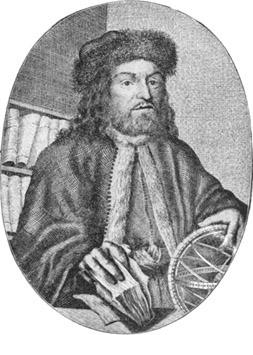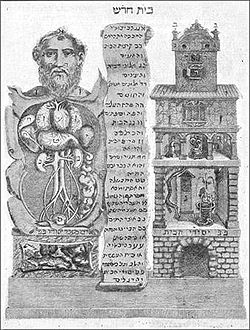
Tobias Cohn
Encyclopedia

Hebrew language
Hebrew is a Semitic language of the Afroasiatic language family. Culturally, is it considered by Jews and other religious groups as the language of the Jewish people, though other Jewish languages had originated among diaspora Jews, and the Hebrew language is also used by non-Jewish groups, such...
, Toviyyah ben Moshe ha-Kohen; in Polish
Polish language
Polish is a language of the Lechitic subgroup of West Slavic languages, used throughout Poland and by Polish minorities in other countries...
, Tobiasz Kohn) (also referred to as Toviyah Kats) (1652-1729) was a Polish-Jewish
History of the Jews in Poland
The history of the Jews in Poland dates back over a millennium. For centuries, Poland was home to the largest and most significant Jewish community in the world. Poland was the centre of Jewish culture thanks to a long period of statutory religious tolerance and social autonomy. This ended with the...
physician of the seventeenth and eighteenth centuries. He was born at Metz
Metz
Metz is a city in the northeast of France located at the confluence of the Moselle and the Seille rivers.Metz is the capital of the Lorraine region and prefecture of the Moselle department. Located near the tripoint along the junction of France, Germany, and Luxembourg, Metz forms a central place...
in 1652.
Biography
Cohn's grandfather was the physician Eleazar Kohn, who emigrated from the Holy LandHoly Land
The Holy Land is a term which in Judaism refers to the Kingdom of Israel as defined in the Tanakh. For Jews, the Land's identifiction of being Holy is defined in Judaism by its differentiation from other lands by virtue of the practice of Judaism often possible only in the Land of Israel...
to Poland
Poland
Poland , officially the Republic of Poland , is a country in Central Europe bordered by Germany to the west; the Czech Republic and Slovakia to the south; Ukraine, Belarus and Lithuania to the east; and the Baltic Sea and Kaliningrad Oblast, a Russian exclave, to the north...
, and settled in Kamenetz-Podolsk, where he practised medicine until his death. His father was the Polish physician Moses Kohn of Narol
Narol
Narol is a town in Podkarpacie Voivodeship, in Lubaczów County, Poland. It had a population of 2,109 as of 2009. Narol is situated in the northeast of Podkarpackie region, in an area called Narolschyzna. The town of Narol regained the rank of 'city' in 1996....
, in the district of Bielsk
Bielsk
Bielsk may refer to the following places:*Bielsk, Kuyavian-Pomeranian Voivodeship *Bielsk, Masovian Voivodeship *Bielsk Podlaski in Podlaskie Voivodeship...
, who moved to Metz in 1648 to escape persecution during the Chmielnicki Uprising. Tobias and his elder brother returned to Poland after the death of their father in 1673. He received his education at Kraków
Kraków
Kraków also Krakow, or Cracow , is the second largest and one of the oldest cities in Poland. Situated on the Vistula River in the Lesser Poland region, the city dates back to the 7th century. Kraków has traditionally been one of the leading centres of Polish academic, cultural, and artistic life...
and the universities of Frankfort-on-the-Oder (at the expense of the great elector of Brandenburg) and Padua
Padua
Padua is a city and comune in the Veneto, northern Italy. It is the capital of the province of Padua and the economic and communications hub of the area. Padua's population is 212,500 . The city is sometimes included, with Venice and Treviso, in the Padua-Treviso-Venice Metropolitan Area, having...
, graduating from the latter as doctor of medicine
Doctor of Medicine
Doctor of Medicine is a doctoral degree for physicians. The degree is granted by medical schools...
. He practised for some time in Poland, and removed later to Adrianople, where he became physician to five successive Ottoman sultans— Mehmed IV
Mehmed IV
Mehmed IV Modern Turkish Mehmet was the Sultan of the Ottoman Empire from 1648 to 1687...
, Suleiman II
Suleiman II
Suleiman II was the Sultan of the Ottoman Empire from 1687 to 1691...
, Ahmed II
Ahmed II
Ahmed II Khan Ghazi was the Sultan of the Ottoman Empire from 1691 to 1695...
, Mustafa II
Mustafa II
Mustafa II Ghazi was the Sultan of the Ottoman Empire from 1695 to 1703.-Life:...
, and Ahmed III
Ahmed III
Ahmed III was Sultan of the Ottoman Empire and a son of Sultan Mehmed IV . His mother was Mâh-Pâre Ummatullah Râbi'a Gül-Nûş Valide Sultan, originally named Evmania Voria, who was an ethnic Greek. He was born at Hajioglupazari, in Dobruja...
, moving with the court to Constantinople
Constantinople
Constantinople was the capital of the Roman, Eastern Roman, Byzantine, Latin, and Ottoman Empires. Throughout most of the Middle Ages, Constantinople was Europe's largest and wealthiest city.-Names:...
. In 1724 he went to Jerusalem, where he lived until his death in 1729.
Writings
Cohn was familiar with ten languages - HebrewHebrew language
Hebrew is a Semitic language of the Afroasiatic language family. Culturally, is it considered by Jews and other religious groups as the language of the Jewish people, though other Jewish languages had originated among diaspora Jews, and the Hebrew language is also used by non-Jewish groups, such...
, German
German language
German is a West Germanic language, related to and classified alongside English and Dutch. With an estimated 90 – 98 million native speakers, German is one of the world's major languages and is the most widely-spoken first language in the European Union....
, Polish
Polish language
Polish is a language of the Lechitic subgroup of West Slavic languages, used throughout Poland and by Polish minorities in other countries...
, Italian
Italian language
Italian is a Romance language spoken mainly in Europe: Italy, Switzerland, San Marino, Vatican City, by minorities in Malta, Monaco, Croatia, Slovenia, France, Libya, Eritrea, and Somalia, and by immigrant communities in the Americas and Australia...
, French
French language
French is a Romance language spoken as a first language in France, the Romandy region in Switzerland, Wallonia and Brussels in Belgium, Monaco, the regions of Quebec and Acadia in Canada, and by various communities elsewhere. Second-language speakers of French are distributed throughout many parts...
, Spanish
Spanish language
Spanish , also known as Castilian , is a Romance language in the Ibero-Romance group that evolved from several languages and dialects in central-northern Iberia around the 9th century and gradually spread with the expansion of the Kingdom of Castile into central and southern Iberia during the...
, Turkish
Ottoman Turkish language
The Ottoman Turkish language or Ottoman language is the variety of the Turkish language that was used for administrative and literary purposes in the Ottoman Empire. It borrows extensively from Arabic and Persian, and was written in a variant of the Perso-Arabic script...
, Latin, Greek
Greek language
Greek is an independent branch of the Indo-European family of languages. Native to the southern Balkans, it has the longest documented history of any Indo-European language, spanning 34 centuries of written records. Its writing system has been the Greek alphabet for the majority of its history;...
, and Arabic
Arabic language
Arabic is a name applied to the descendants of the Classical Arabic language of the 6th century AD, used most prominently in the Quran, the Islamic Holy Book...
. This great linguistic knowledge made it possible for him to write his Ma'aseh Toviyyah
Ma'aseh Toviyyah
Ma'aseh Toviyyah or Ma'aseh Tobiyyah was an encyclopedic scientific reference book written by Tobias Cohn. It was published in Venice, Italy in 1707, and reprinted there in 1715, 1728, 1769, and 1850....
(Work of Tobias), published in Venice, Italy in 1707, and reprinted there in 1715, 1728, 1769, and 1850. The work is encyclopedic, and is divided into eight parts: (1) theology; (2) astronomy; (3) medicine; (4) hygiene; (5) syphilitic maladies; (6) botany; (7) cosmography; and (8) an essay on the four elements.

In part 2 are found an astrolabe
Astrolabe
An astrolabe is an elaborate inclinometer, historically used by astronomers, navigators, and astrologers. Its many uses include locating and predicting the positions of the Sun, Moon, planets, and stars, determining local time given local latitude and longitude, surveying, triangulation, and to...
and illustrations of astronomical and mathematical instruments. Inserted between parts 6 and 7 is Turkish-Latin-Spanish dictionary
Dictionary
A dictionary is a collection of words in one or more specific languages, often listed alphabetically, with usage information, definitions, etymologies, phonetics, pronunciations, and other information; or a book of words in one language with their equivalents in another, also known as a lexicon...
; and prefixed to the work is a poem by Solomon Conegliano.
Cohn's medical knowledge and experiences seem to have been of considerable importance. He gave, from his own observations, the first description of the "plica polonica," as well as many local symptoms and newly discovered medicinal herbs. He also published in three languages a list of remedies.
He criticized the anti-Semitic professors of Frankfort-on-the-Oder as well as his coreligionists who were devoted to Kabbalah
Kabbalah
Kabbalah/Kabala is a discipline and school of thought concerned with the esoteric aspect of Rabbinic Judaism. It was systematized in 11th-13th century Hachmei Provence and Spain, and again after the Expulsion from Spain, in 16th century Ottoman Palestine...
and committed to a blind belief in miracle
Miracle
A miracle often denotes an event attributed to divine intervention. Alternatively, it may be an event attributed to a miracle worker, saint, or religious leader. A miracle is sometimes thought of as a perceptible interruption of the laws of nature. Others suggest that a god may work with the laws...
s.

